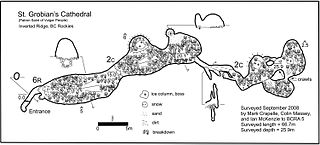Related Research Articles

The National Speleological Society (NSS) is an organization formed in 1941 to advance the exploration, conservation, study, and understanding of caves in the United States. Originally headquartered in Washington D.C., its current offices are in Huntsville, Alabama. The organization engages in the research and scientific study, restoration, exploration, and protection of caves. It has more than 10,000 members in more than 250 grottos.
Abrakurrie Cave is a wild cave on the Nullarbor Plain in Western Australia. It is located about 48 kilometres (30 mi) north west of Eucla and is reported to have the largest single cave chamber in the southern hemisphere, and that stencils in the cave are the deepest penetration of Aboriginal art of any cave system in Australia.
Formed in 1956, the Australian Speleological Federation Inc. (ASF) is the national body representing those interested in the protection and sustainability of Australia's cave and karst environments. It has approximately 850 members across 28 constituent bodies throughout all Australian states and territories.
Eli "Cymmie" Simpson was an influential and controversial British caver and speleologist, and a founding member and Recorder of the British Speleological Association.

A cave survey is a map of all or part of a cave system, which may be produced to meet differing standards of accuracy depending on the cave conditions and equipment available underground. Cave surveying and cartography, i.e. the creation of an accurate, detailed map, is one of the most common technical activities undertaken within a cave and is a fundamental part of speleology. Surveys can be used to compare caves to each other by length, depth and volume, may reveal clues on speleogenesis, provide a spatial reference for other areas of scientific study and assist visitors with route-finding.
Trevor David Ford, OBE was an English geologist, specialising in speleology, and an author. He was a Senior Lecturer in the Geology Department of the University of Leicester, and also Associate Dean of Science.

The British Cave Research Association (BCRA) is a speleological organisation in the United Kingdom. Its object is to promote the study of caves and associated phenomena, and it attains this by supporting cave and karst research, encouraging original exploration, collecting and publishing speleological information, maintaining a library and organising educational and scientific conferences and meetings.
There are a number of caving organizations throughout the world.

Recreational caving in the United Kingdom dates back to the mid nineteenth century. The four major caving areas of the United Kingdom are North Yorkshire, South Wales, Derbyshire, and the Mendips. Minor areas include Devon, North Wales, and Grampian.

Named after Eli Simpson, Simpson Pot is a limestone cave in West Kingsdale, North Yorkshire, England. It leads into Swinsto Cave and thence into Kingsdale Master Cave, and it is popular with cavers as it is possible to descend it by abseiling down the pitches, retrieving the rope each time, and exiting through Valley Entrance of Kingsdale Master Cave at the base of the hill. It is part of a 27-kilometre (17 mi) long cave system that drains both flanks of Kingsdale.
Cave conservation is the protection and restoration of caves to prevent or minimise the effects of human activities.

The British Caving Association (BCA) is the sports governing body for caving in the United Kingdom. It is recognised by UK Sport, Sport England and SportScotland.

The Speleological Union of Ireland (SUI) is the official representative body of cavers in Ireland, both in the Republic of Ireland and in Northern Ireland. It is affiliated with the Irish Cave Rescue Organisation.
John (Jack) Cristopher Coleman (1914–1971) was a respected Irish geographer, archaeologist, speleologist and mountaineer. He devoted much of his life to the study of the caves of Ireland, the product of which were his many contributions to scientific journals in Ireland and the United Kingdom, his founding of the Speleological Society of Ireland and the publishing of his book, The Caves of Ireland.

Mirko Malez was a prominent Croatian palaeontologist, speleologist, geo-scientist, ecologist and natural history writer. He was known as a "pioneer of Croatian speleoarchaeology". He was a member of the Yugoslav Academy, JAZU (present-day Croatian, HAZU - Croatian Academy of Sciences and Arts and one of only four Croatian PhDs of speleology. Thanks to Malez's popularization of science, Varaždin County, in northern Croatia, is also known as a "cradle of the Palaeolithic age".
Therion is free and open-source cave surveying software designed to process survey data, generate maps and 3D models of caves, and archive the data describing the cave and the history of exploration.
John Wilfrid Jackson was a British conchologist, archaeologist and geologist.

The Three Counties System is a set of inter-connected limestone solutional cave systems spanning the borders of Cumbria, Lancashire and North Yorkshire in the north of England. The possibility of connecting a number of discrete cave systems in the area to create a single super-system that spans the county borders was first proposed by Dave Brook in 1968, and it was achieved in 2011. The system is currently over 86 kilometres (53 mi) long, making it the longest in the UK and the twenty-ninth longest in the world, and there continues to be scope for considerably extending the system.

Swinsto Cave is a limestone cave in West Kingsdale, North Yorkshire, England. It leads into Kingsdale Master Cave and it is popular with cavers as it is possible to descend by abseiling down the pitches, retrieving the rope each time, and exiting through Valley Entrance of Kingsdale Master Cave at the base of the hill. It is part of a 27-kilometre (17 mi) long cave system that drains both flanks of Kingsdale.
References
- ↑ Craven, Stephen (December 2001). "The British Speleological Association (1935–1973) and its founder Eli Simpson". Cave and Karst Science. British Cave Research Association. 28 (3).